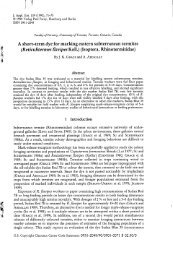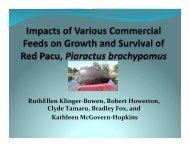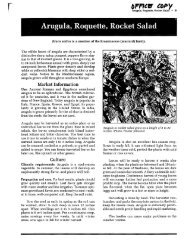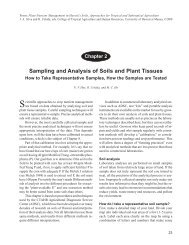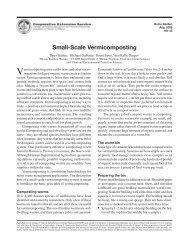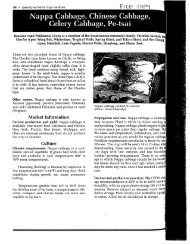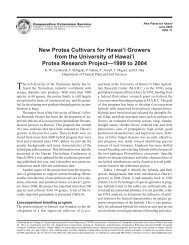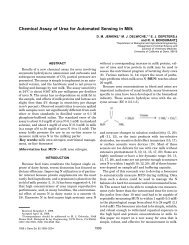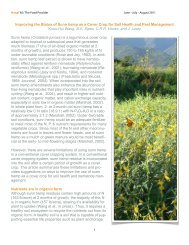Corky Bark Disease of Rambutan - ctahr
Corky Bark Disease of Rambutan - ctahr
Corky Bark Disease of Rambutan - ctahr
Create successful ePaper yourself
Turn your PDF publications into a flip-book with our unique Google optimized e-Paper software.
Plant <strong>Disease</strong><br />
May 2012<br />
PD-86<br />
<strong>Corky</strong> <strong>Bark</strong> <strong>Disease</strong> <strong>of</strong> <strong>Rambutan</strong><br />
Bruce Combs 1 , Mark Nickum 1 , and Scot Nelson 2<br />
1<br />
Department <strong>of</strong> Tropical Plant and Soil Sciences<br />
2<br />
Department <strong>of</strong> Plant and Environmental Protection Sciences<br />
<strong>Rambutan</strong> (Nephelium lappaceum L.) is a tropical<br />
tree in the family Sapindaceae that produces delicious<br />
fruits. It is native to Malaysia and Indonesia and<br />
is cultivated throughout Southeast Asia. It is also grown<br />
from sea level to 600 m (2,000 feet) in other tropical,<br />
humid regions with well-distributed rainfall. In its native<br />
range, rambutan flowers in response to water stress.<br />
A typical weather pattern that triggers flowering is a<br />
monsoon season followed by a dry season (Rossman et<br />
al. 2010). In some areas, including Hawai‘i, rambutan<br />
may produce two crops per year. Hawai‘i tends to have<br />
a short dry period during the winter and another in the<br />
spring, permitting one crop in late spring and another in<br />
early summer (Nagao 2009).<br />
In 2008, 70 farms in Hawai‘i produced 204<br />
metric tons (450,000 pounds) <strong>of</strong> rambutan valued at<br />
US$1,080,000. The relatively high return is due to<br />
the fact that exotic tropical specialty fruits (including<br />
rambutan, longan, and lychee) bring higher farm prices<br />
(NASS-USDA 2010).<br />
Here we discuss the etiology and management <strong>of</strong><br />
a fungal disease <strong>of</strong> rambutan known as “corky bark.”<br />
The disease causes conspicuous and easily recognizable<br />
symptoms (Fig. 1), especially when rambutan is grown<br />
in such high-rainfall areas <strong>of</strong> Hawai‘i as regions <strong>of</strong> the<br />
Hämäkua coast on the island <strong>of</strong> Hawai‘i. The disease also<br />
affects other host species such as lychee (Litchi chinensis)<br />
and pulasan (Nephelium mutabile).<br />
<strong>Disease</strong> symptoms<br />
<strong>Corky</strong> bark first appears as small to large irregular patches<br />
<strong>of</strong> raised bark on the main trunk and lateral branches<br />
<strong>of</strong> trees. As the disease develops on a tree, the pathogen<br />
disperses from the older, previously infected stems to<br />
the younger stems, although initially the younger shoots<br />
or branches may display no symptoms as the infection<br />
incubates. As the disease spreads to twigs or young stems,<br />
the corky areas appear as roughly textured golden brown<br />
lumps that protrude from the bark (Fig. 2). As the stems<br />
and branches grow and as lesions age, the lumps enlarge<br />
and become more corky and rough in texture (Fig. 3).<br />
The bark cracks open, and stem and branch cankers<br />
form, turning black in color (Fig. 4). These symptoms<br />
may also appear on the stems <strong>of</strong> rootstocks. The cankers<br />
are slightly roughened and irregular to spherical in appearance.<br />
They are usually raised about 1 cm (0.4 inch)<br />
from the bark surface and have deep fissures in which<br />
sexual fruiting bodies (ascomata) <strong>of</strong> the pathogen develop<br />
<strong>Corky</strong> bark disease on rambutan appears as small to<br />
large raised, irregular blackened cankers.<br />
Published by the College <strong>of</strong> Tropical Agriculture and Human Resources (CTAHR) and issued in furtherance <strong>of</strong> Cooperative Extension work, Acts <strong>of</strong> May 8 and June 30, 1914, in cooperation<br />
with the U.S. Department <strong>of</strong> Agriculture, under the Director/Dean, Cooperative Extension Service/CTAHR, University <strong>of</strong> Hawai‘i at Mānoa, Honolulu, Hawai‘i 96822.<br />
Copyright 2011, University <strong>of</strong> Hawai‘i. For reproduction and use permission, contact the CTAHR Office <strong>of</strong> Communication Services, ocs@<strong>ctahr</strong>.hawaii.edu, 808-956-7036. The university is<br />
an equal opportunity/affirmative action institution providing programs and services to the people <strong>of</strong> Hawai‘i without regard to race, sex, gender identity and expression, age, religion, color,<br />
national origin, ancestry, disability, marital status, arrest and court record, sexual orientation, or status as a covered veteran. Find CTAHR publications at www.<strong>ctahr</strong>.hawaii.edu/freepubs.
UH–CTAHR <strong>Corky</strong> <strong>Bark</strong> <strong>Disease</strong> <strong>of</strong> <strong>Rambutan</strong> PD-86 — May 2012<br />
Fig. 2. The initial symptoms <strong>of</strong> corky bark on young<br />
twigs and stems are small, raised golden brown or beige<br />
patches <strong>of</strong> roughly textured intumescence.<br />
Fig. 3. As the initial symptoms age on rambutan, the color<br />
<strong>of</strong> the corky tissue changes from golden brown or beige<br />
to black, and the texture becomes more rough.<br />
Fig. 4. Cankers, which form on woody branches, are<br />
dark brown to black, slightly roughened, and irregularly<br />
spherical in appearance. Cankers are raised from the<br />
bark surface, with deep fissures.<br />
Fig. 5. The corky, cankerous galls can protrude noticeably<br />
from stems.<br />
(Rossman et al. 2010) (Fig. 5). In high-rainfall areas, the<br />
corky cankers absorb moisture, leading to a premature<br />
rotting <strong>of</strong> their tissues (Fig. 6). In severe cases, dieback <strong>of</strong><br />
entire branches occurs, although it may take years for a<br />
tree to become so severely affected. Trees have not been<br />
reported killed by the disease, but severe infections (Fig.<br />
7) reduce tree growth (Rossman et al. 2010).<br />
In Hawai‘i, corky bark is widely distributed on rambutan<br />
farms throughout the wet areas <strong>of</strong> the Hämäkua<br />
coast on the island <strong>of</strong> Hawai‘i, from Hilo to Honoka‘a<br />
and Waimea. On several farms, all <strong>of</strong> the rambutan trees<br />
show symptoms <strong>of</strong> the disease. Some farmers claim that<br />
the disease does not reduce yields or negatively affect the<br />
health <strong>of</strong> their trees; however, the effect <strong>of</strong> corky bark<br />
disease on yield and plant health in Hawai‘i has not been<br />
fully evaluated.<br />
Pathogen<br />
Dolabra nepheliae is a plant-pathogenic fungus that<br />
causes extensive bark cankers and deep fissures on<br />
stems and branches <strong>of</strong> rambutan (Rossman et al. 2010).<br />
As the sexual stage <strong>of</strong> the pathogen, D. nepheliae represents<br />
a new lineage within the Eurotiomycetes and is<br />
related to Phaeomoniella chlamydospora, the causal<br />
agent <strong>of</strong> Petri grapevine decline. The pathogen was first<br />
described in Malaysia, has been reported in Australia<br />
and Puerto Rico, and was first found in Hawai‘i in<br />
Kïlauea, Kaua‘i, in 1984. The fungus may have been in<br />
2
UH–CTAHR <strong>Corky</strong> <strong>Bark</strong> <strong>Disease</strong> <strong>of</strong> <strong>Rambutan</strong> PD-86 — May 2012<br />
Fig. 6. The highly corky areas <strong>of</strong> severely affected<br />
branches absorb and retain water, which can enhance<br />
the premature decay <strong>of</strong> infected branches and allow<br />
mosses and lichens to colonize the branches and become<br />
established.<br />
Fig. 7. Infections may be present on virtually every branch<br />
<strong>of</strong> a diseased rambutan.<br />
Fig. 8. Pulasan branch with symptoms <strong>of</strong> corky bark<br />
disease.<br />
Fig. 9. Lychee with symptoms <strong>of</strong> corky bark.<br />
Hawai‘i for some time before that, though, most likely<br />
in residential gardens (Rossman et al. 2010). In 2001,<br />
D. nepheliae was observed as growth on twigs and<br />
branches <strong>of</strong> rambutan trees in a commercial orchard in<br />
the Papa‘ikou area <strong>of</strong> the South Hilo district on the Big<br />
Island. In 2007, it was isolated from cankers on rambutan<br />
in a USDA greenhouse in Hilo (Rossman et al. 2010).<br />
The pathogen and disease also occur on pulasan (Fig.<br />
8) and lychee (Fig. 9) outside <strong>of</strong> Hawai‘i, and have also<br />
been detected on these species as well as on related<br />
Nephelium species in Hawai‘i. The characteristic appearance<br />
<strong>of</strong> the disease on the stems and the symptom<br />
severity can differ noticeably among varieties <strong>of</strong> lychee.<br />
Pathogen life cycle<br />
Dolabra nepheliae belongs to the Ascomycota, the largest<br />
phylum in the Kingdom Fungi. The defining feature<br />
<strong>of</strong> the ascomycetes is a microscopic structure called the<br />
ascus, in which the fungus forms sexual spores called<br />
ascospores. However, the asexual stage <strong>of</strong> fungi in the<br />
Ascomycota is usually the form responsible for repeated<br />
infection cycles and epidemics. The asexual stage <strong>of</strong><br />
D. nepheliae, the form most commonly found, was described<br />
as Rhabdospora nepheliae sp. nov (Zalasky et<br />
al. 1971). The asexual spores <strong>of</strong> this fungus, the conidia,<br />
form in flask-shaped structures called pycnidia, at the tips<br />
<strong>of</strong> specialized hyphae (Rossman et al. 2010). These spe-<br />
3
UH–CTAHR <strong>Corky</strong> <strong>Bark</strong> <strong>Disease</strong> <strong>of</strong> <strong>Rambutan</strong> PD-86 — May 2012<br />
cialized hyphae, or conidiophores, are branched filaments<br />
<strong>of</strong> the fungus that grow from the inner walls <strong>of</strong> pycnidia.<br />
How this fungus survives and spreads has yet to<br />
be determined. In general, parasitic fungi can coexist<br />
with their perennial hosts for years as resting spores,<br />
reproductive structures, or hyphae. Some fungi, known<br />
as facultative parasites, can live as saprophytes in plant<br />
debris or in the soil and then are able to infect their host<br />
plants in favorable environments defined by optimum<br />
temperature and moisture levels (Schumann and D’Arcy<br />
2010). The thickened, dark brown to black cell walls <strong>of</strong><br />
the ascomata and pycnidia <strong>of</strong> D. nepheliae are adaptations<br />
that protect them from drought, UV radiation, and<br />
microbial enzymes.<br />
Air movement and splashing or wind-driven rain<br />
commonly distribute fungal spores. They are also vectored<br />
by insects and spread by contact with humans,<br />
machinery, or tools. Asci that contain the sexual spores<br />
<strong>of</strong> D. nepheliae are capable <strong>of</strong> forcibly discharging<br />
these spores into the moving air surrounding them.<br />
It is also possible that ascospores discharged from<br />
plant debris in the soil could directly infect trees.<br />
<strong>Disease</strong> management<br />
No management practices have been published for this<br />
disease specifically, and no fungicides have been identified<br />
to control it. Efforts are reportedly underway to study<br />
the potential damage <strong>of</strong> the disease and mechanisms<br />
to control it. This includes the introduction <strong>of</strong> diseaseresistant<br />
clones (Rossman et al. 2007).<br />
In rambutan variety trials in Puerto Rico, the cultivar<br />
‘Gula Batu’ was found to have some tolerance to stem<br />
cankers caused by D. nepheliae. This would <strong>of</strong>fer farmers<br />
an alternative to treatment in areas where the fungus is a<br />
serious problem (Goenaga and Jenkins 2011), but to date<br />
it has not been grown or evaluated in Hawai‘i. Currently<br />
it is unknown if corky bark disease has a significant<br />
negative impact on overall tree health or fruit yields.<br />
Therefore we do not advocate destroying symptomatic<br />
trees. Rather, some simple sanitation procedures may be<br />
able to suppress the disease.<br />
Greater knowledge <strong>of</strong> the disease cycle on rambutan<br />
is essential for deciding on a species-specific management<br />
plan. The following are general methods used to<br />
manage fungal diseases:<br />
• Exclusion. Protect trees that are free from the fungus.<br />
Do not introduce young trees or propagative<br />
material from areas or farms in which the fungus<br />
is present. Do not intercrop rambutan with lychee<br />
or pulasan.<br />
• Sanitation. Removal <strong>of</strong> affected trees is not necessary.<br />
Complete eradication <strong>of</strong> trees, if it were possible,<br />
would probably require the cooperation <strong>of</strong> all<br />
growers in an area in order to eradicate the disease.<br />
However, pruning branches with severe symptoms<br />
to reduce the spread <strong>of</strong> spores to new infection sites<br />
can help to manage the disease. After pruning rambutan<br />
trees, practice sanitation by removing crop<br />
debris from the field. Removing infested debris may<br />
significantly reduce the pathogen population.<br />
• Avoidance. Choose planting sites where corky<br />
bark is absent or not known to be severe. Avoid<br />
environmental conditions favoring fungal diseases,<br />
especially rainy locations where diseases tend to occur.<br />
Plant tree rows parallel to prevailing winds and<br />
choose a planting density (number <strong>of</strong> plants per acre)<br />
that will allow the orchard to dry more quickly after<br />
a rainfall. As trees mature, prune them to increase air<br />
circulation in the canopy. Control weeds to reduce<br />
relative humidity in the plant canopy.<br />
• Protection. Disinfest pruning equipment between<br />
cuts in a solution <strong>of</strong> 10% bleach to decrease spread<br />
<strong>of</strong> the pathogen during pruning operations. Keep<br />
work in orchards to a minimum when diseased trees<br />
are wet. This will reduce the chance <strong>of</strong> spreading<br />
spores <strong>of</strong> the fungus within and among moist trees.<br />
Acknowledgements<br />
The authors thank Fred Brooks <strong>of</strong> UH-CTAHR for his<br />
thoughtful review <strong>of</strong> this manuscript.<br />
References<br />
Goenaga, R, and Jenkins, D. 2011. Yield and fruit quality<br />
traits <strong>of</strong> rambutan cultivars grafted onto a common<br />
rootstock and grown at two locations in Puerto Rico.<br />
HortTechnology 21:136–140.<br />
Nagao, M. 2009. Industry Analysis: Identifying Research<br />
and Extension Priorities for Hawai‘i’s Avocado,<br />
Banana, Citrus, and Specialty Fruits. Cooperative<br />
4
UH–CTAHR <strong>Corky</strong> <strong>Bark</strong> <strong>Disease</strong> <strong>of</strong> <strong>Rambutan</strong> PD-86 — May 2012<br />
Extension Service, College <strong>of</strong> Tropical Agriculture<br />
and Human Resources, University <strong>of</strong> Hawai‘i at<br />
Mänoa.<br />
Rossman, AY, Schoch, CL, Farr, DF, Nishijima, K,<br />
Keith, L, and Goenaga, R. 2010. Dolabra nepheliae<br />
on rambutan and lychee represents a novel lineage<br />
<strong>of</strong> phytopathogenic Eurotiomycetes. Mycoscience<br />
51:300–309.<br />
Rossman, AY, Goenaga, R, and Keith, L. 2007. First<br />
report <strong>of</strong> Dolabra nepheliae on rambutan and litchi<br />
in Hawaii and Puerto Rico. Plant <strong>Disease</strong> 91:1685.<br />
Schumann, GL, and D’Arcy, CJ. 2010. Essential Plant<br />
Pathology, 2nd ed., American Phytopathological<br />
Society, St. Paul, MN.<br />
United States Department <strong>of</strong> Agriculture, National<br />
Agricultural Statistics Service. 2012. Statistics <strong>of</strong><br />
Hawaii Agriculture. http://www.nass.usda.gov/<br />
Statistics_by_State/Hawaii/Publications/Annual_<br />
Statistical_Bulletin/ (data for tropical specialty fruits<br />
from 2010).<br />
Zalasky, H, Nawawi, A, Ting, WP, and Tai, LH. 1971.<br />
Dolabra nepheliae and its imperfect state associated<br />
with canker <strong>of</strong> Nephelium lappaceum and N.<br />
mutabile. Canadian Journal <strong>of</strong> Botany 49:559–561.<br />
5



